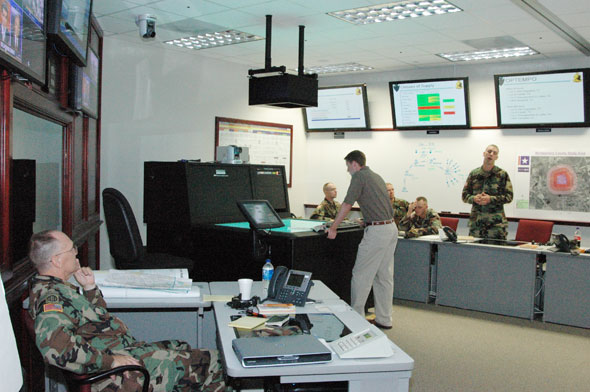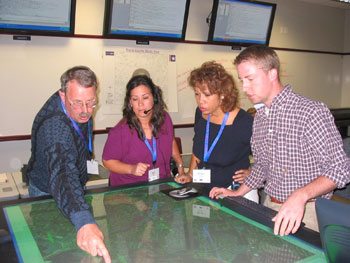Facility, Program Prepare Groups For Emergencies
 |
| The National Guard utilizes the Incident
Command Simulation Training program's command suite as
a "real-life command center" during Hurricane
Rita, when evacuees were sheltered at SHSU. |
A student walks into a high school, opens fire and begins
taking hostages. An airplane carrying 150 passengers crashes
in a field near your city. A Category 4 hurricane is threatening
your town.
What would you do in any of those scenarios? Would you be
prepared to handle all of the issues and repercussions that
may result?
Dealing with those types of emergencies is exactly what Sam
Houston State University’s new Incident Command Simulation
Training program has been teaching Texas law enforcement agencies
and other organizations for the past 18 months.
InCoSiT is the only one of its type in the United States,
according to director David Webb, who designed the program
with colleague Hakan Can at the university’s Bill Blackwood
Law Enforcement Management Institute of Texas. The idea came
from Webb’s experience with the British police service.
“One of the priorities for commanders in Britain is
to have training on critical incident command. We would carry
out table-top exercises, as well as major real-time exercises,”
Webb said. “A few years ago LEMIT wasn’t delivering
any critical incident management training.
“We thought we would try and design a system where you
would put people in what we call an immersive training environment,”
he said. “An immersive training environment is one where
the participants actually believe that they are dealing with
an incident because their working environment it as life-like
as we can make it.”
Now, two and a half years later, a year of which was design
and building, InCoSiT has trained incident command teams from
around the state of Texas, as well as ones from South American
states.
“We train participants on a wide range of critical incidents,
ranging from a variety of man-made to natural disasters, so
we’ll look at terrorism, the bird flu, ricin, as well
as train derailments, a plane crash, a hostage taking a school
or university and hurricanes,” Webb said. “We
try and train the people in things they are likely to deal
with.
“I think what makes us different from other training
providers is that we don’t come up with fantastic ideas
about helicopters crashing down on people, where people can’t
win in the situation,” he said. “We want people
to win; we want them to make good decisions and get themselves
out of critical incidents. That is really what it is all about
– the capability of critical incident command teams
to make sound decisions.”
The university-funded complex includes a suite of three rooms:
a classroom, where participants watch each other in action;
a control room, where InCoSiT staff members run the simulation;
and a command suite, where a nine-person command team runs
through real-life scenarios in real time.
To make the training session as real as possible, InCoSiT
works with CBS in Bryan-College Station to develop “breaking
news” scenarios that will interrupt one of the four
newscasts on a split-screen television.
When this happens, the command team goes into the command
suite and begins working to solve the issue at hand.
“We train people according to roles. Within the command
teams there is obviously a commander; then there are eight
other roles. We train the operations guy, the logistics person,
the public information officer, and there are specific duties,”
Webb said. “If they know that role, they can fit into
a command team operating anywhere. So, you’re not just
training a group of people to work with each other, you are
training specific roles within a team.”
The simulation is run in “real time,” meaning
the events unfold as they would in an actual, real-life situation,
sometimes lasting four to 10 hours, Webb said.
“We have the capacity to interject a breaking news story
in a regular TV broadcast, so participants really think that
the breaking news stories are real. We will run incidents
for the same amount of time as they would take on the street,”
he said.
“So there’s no stopping for a cup of coffee or
anything like that,” he said. “After we’ve
been going for an hour or so, we might change over and take
one team out and put another one in, but we keep the scenario
running. The action keeps going even though one team is briefing
an incoming team – just in the same way as it would
happen in a real operation.”
The exercises can be very stressful for participants, but
the whole purpose of the program is to encourage people to
formulate plans, ask the right questions and make the right
decisions.
“It gets quite warm in here; it’s quite a production,”
he said. “It’s not a cheap form of training. There
is plenty of that about, and that’s what people get
– cheap training; the LEMIT program is a real quality
program.
“This whole thing, critical incidents management, is
about the quality of the decision that command teams make,
so there is a great emphasis of decision-making,” he
said. “We also train on elements of leadership and team
building because those are important as well.”
 |
| Trainees look at a map on the Digital
Imaging Table. |
The training complex is supported through many advanced technological
devices, from flat-screen televisions and a projector in the
classroom to the numerous work stations, complete with computers,
phones and televisions that show what everyone is working
on, as well as small microphones embedded in the ceiling of
the command suite, which allow the classroom participants
to hear what is going on in crystal-clear sound.
“We rely very heavily on GIS, geographical information
systems, and we use a lot of maps, and aerial photographs,”
he said “We can take you down into a high school with
three-dimensional maps and fly you in and around (buildings).”
In addition, a $350,000 piece of equipment, called a Digital
Imaging Table, allows for a combination of multimedia including
enhanced computer graphics to be displayed.
“You can bring together aerial photography, over-flights
by planes and embed that with maps and lots of different layers
of data. Whichever combination you want to show, you can,”
Webb said. “If you click on a spot on a map, it will
actually explode to show you where you are, like movie pictures—it
has that sort of capability. So if people ask for the right
data, it should give them much better information upon which
they can make a decision.”
The command suite was even used for seven days and seven nights
by the National Guard when refugees were brought to Huntsville
during Hurricane Rita, serving as a “real-life command
center,” he said.
In addition, the suite will be used to train two teams for
SHSU to handle such cases as last year’s hurricane.
“They did a great job last year; this is just to try
to do it even better,” Webb said.
While Texas law enforcement agencies are trained for free
under the LEMIT charter, InCoSiT will also train others, such
as emergency medical services, fire service, public works,
health care, public health and education and campus safety
for a fee.
“The nationally-mandated response is one of unified
command, which is not just police working in isolation,”
Webb said. “It can be whatever agencies need to be working
together to provide the appropriate management response.”
Training sessions are usually 40 hours and designed for 30
participants. LEMIT’s staff includes Debra Gawron, who
has a long history training critical incident management,
and Magdalena McMillan, the program coordinator at InCoSiT,
who is one of the few instructors in Texas qualified to train
managers at the “300” and “400” FEMA
levels.
The specialized training received through InCoSiT is in compliance
with Federal Emergency Management Agency, the National Incident
Management System and National Response Plan guidelines.
Participants receive certification from the Texas Commission
on Law Enforcement Officer Standards and Education, the State
Board of Education and Commissioner.
For more information, or to take a virtual tour of the facility,
visit http://www.incosit.org.
—END—
SHSU Media Contact: Jennifer
Gauntt
August 3, 2006
Please send comments, corrections, news tips to Today@Sam.edu.
|


